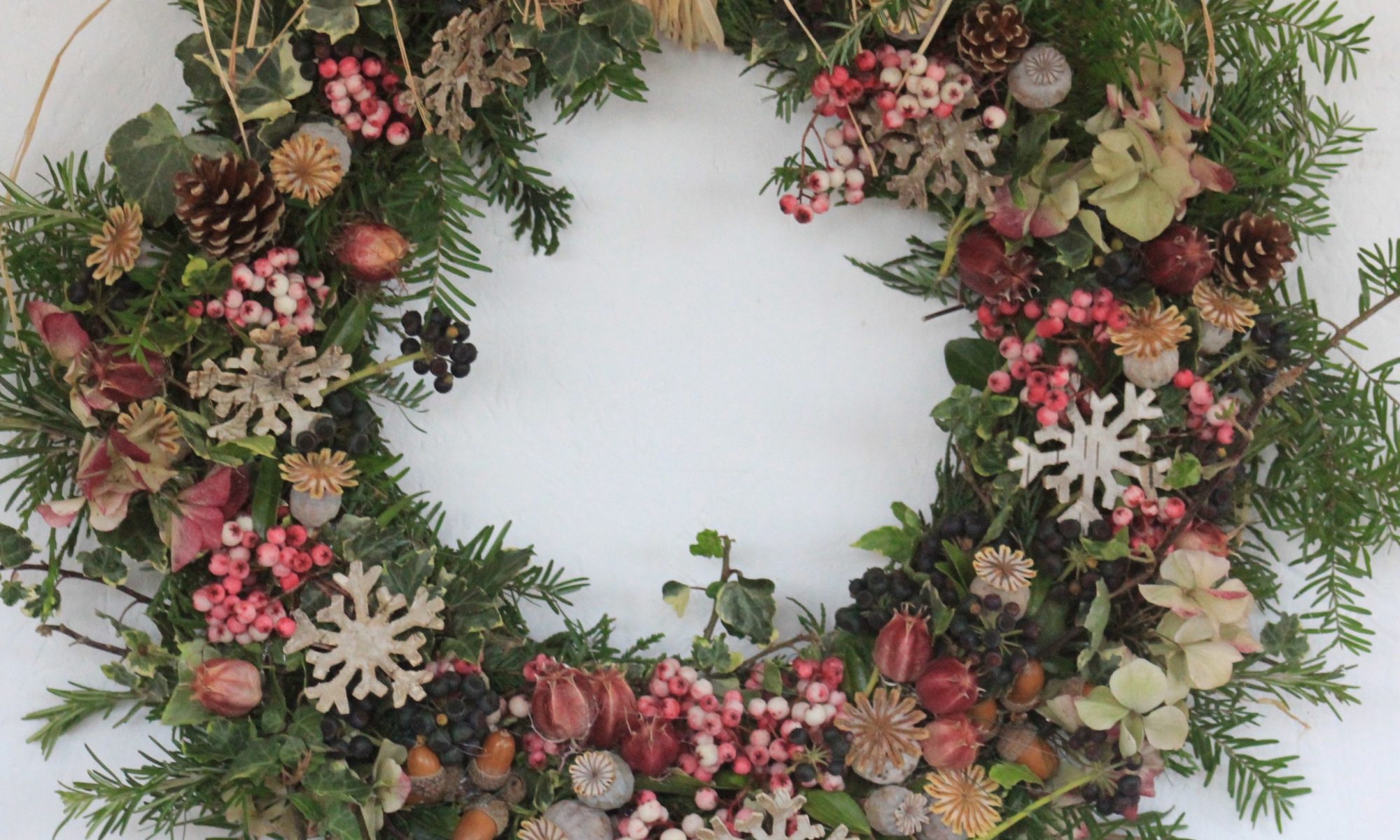Ditch the plastic says Jo Arnell and decorate your home with boughs of real holly (and other lovely things).
Our Christmas decoration box is full, we’re wading through clutter and I really do want to cut back on plastic and un-recyclable trimmings. It will take nerves of steel, though, as the shops are packed with gorgeousness, but there are some surprisingly useful and beautiful things for decorating in the garden too. And they come with added benefits.
Organic decorations won’t clog up your life or your loft – they’ll just fade naturally and sweetly away after Christmas. Making naturally festive decorations will satisfy that creative urge (even if it is buried as deeply as last year’s fairy lights). When it’s all over they’ll leave no trace, no footprint, except perhaps a momentary one in the snow as we trudge down to the compost heap.
Festive Foraging
Serotonin levels drop as the amount of daylight decreases. We produce far less of this mood-enhancing chemical in the low winter light. Seasonal Affective Disorder is a real thing and can make us sluggish and out of sorts – even causing severe depression. Outdoor exercise at this time of the year will help to keep serotonin levels up. Added to this is the dopamine effect of picking and gathering. Dopamine is the ‘reward’ chemical released in the brain’s reward centre (also triggered by gaming and shopping, but originally meant for hunter-gathering). A winter walk, especially one with a purpose, will definitely help to lift the mood.
The tree
Whether it’s a traditional Norway spruce, non-drop Nordman or fancy blue job, nothing beats a real tree. Admittedly they do need a bit of maintenance to stay at their fulsome, fragrant best through the festivities and even the non-drop varieties shed a bit, but they are more environmentally friendly than fake versions.
No matter how many years an artificial tree is kept, it will probably end up as more plastic in landfill, it was made using the earth’s resources and quite possibly it had to travel many miles across an ocean to reach your hearth.
Making your tree last
Keep it outside for as long as you can before bringing into the dry indoor heat.
Chop a little off the bottom to freshen up the stump and put it in water straightaway (many Christmas tree stands have a built-in water reservoir).
Position it away from radiators and open fires.
Water every day. Like a cut flower it will carry on taking water up through the trunk for a good while.
An alternative to a whole evergreen tree is to use an artistically shaped branch, or bunch of twigs cut from a tree or shrub with attractive stems, like Silver Birch, Cornus (Dogwood), or Willow (as seen in this Christmas house). These look best treated simply and hung with just a few berries, baubles or fairy lights.
Berry and Bright
Use real berries and fruits to decorate both the tree and the house, they will last a long time – admittedly not as long as their plastic equivalents, but that is only to be celebrated.
Berries might traditionally come in red, but there are many other colours to mix into your festive scheme.
Sorbus (Rowan/Moutain Ash) cultivars are available with multi-coloured berries: Sorbus hupehensis ‘Pink Pagoda’ (pink), ‘Joseph Rock’ – yellow and Sorbus cashmiriana has white berries. Our native Spindle tree (Euonymus europaeus) can be found in the hedgerows and has bright orange berries in a pink casing, although annoyingly, these are often over by Christmas.
The black clusters of ivy berries look great in wreaths and swags, as do rosehips. For an unreal-looking, metallic purple try the berries of Callicarpa bodinieri. Remember to compensate wildlife if you take berries and fruits.
Seedheads and cones
Many dried seed pods can be made to look festive, but you may need to think ahead with these. Skeletal forms and the tracery of stems and umbellifers make delicate and understated decorations. Collect them once they’re dry, but before the weather gets to them, as they can quickly rot away to un-festive sludge in wet winter conditions. They can be picked weeks, if not months in advance and stored as dried arrangements.
Mini cones of alder and beech are great for decorating wreaths and table displays. Teasel heads can also be used in wreaths, or as tree decorations, but they are prickly, so handle with care. The orange seed cases of Physalis will add drama to decorations in their complete state, but occasionally the casing is eaten away to make a delicately skeletal form that can look as lovely as any bauble. Allium seed heads look like glamorous decorations whether left in a natural state or sprayed silver for extra sparkle.
Faded flowers and bracts
Hydrangea heads dry and last well, as do the skeletal forms of Fennel and Angelica, or hedgerow umbellifers like wild carrot and Joe-Pye weed. The flowers of ornamental grasses can be used to good effect too.
Equipment
You won’t need much: a pair of secateurs and gardening gloves (if you’re rummaging through the hedgerows and picking prickly bits), some florists’ wire and ribbon for hanging things. A glue gun is a useful thing if spherical fruits and seedheads can’t be wired on and for creations that need to hang outside in the weather for any length of time.
Fresh foliage and long-lasting leaves
Once you start looking in the garden it’s amazing to discover how many ordinary plants, that we mostly ignore, are naturally decorative in winter. Evergreen leaves tend to be glossy, which also helps to stop them losing moisture once they’re brought inside. Some may need a splash of water, or hunk of soaking oasis foam to keep them looking lively, but many stay surprisingly fresh-looking all through the festive season. Some of the best long-lasting foliage plants:
Holly – very traditional, but can be a bit prickly and hard on the fingers – wear gloves.
Ivy – still one of the best Christmas evergreens, with long pliable stems, attractive leaves, flowers and fruits. The variegated forms add a touch of white or gold for contrast.
Spotted Laurel (Aucuba japonica) – can be used as a wreath base, or to line a plain bowl piled with nuts or clementines).
Conifer foliage – effective as a wreath or swag base and many varieties are scented.
Viburnum tinus – often overlooked in the garden for much of the year: a dark green blob that blends into the background, but it lasts very well inside and often has the added bonus of winter flowers too.
Pittosporum – leaves on this delicate looking evergreen last very well among cut flowers, but go carefully as some varieties aren’t as robust and frost-hardy as our native evergreens and won’t appreciate a mid-winter hacking.
Herbs – are lovely fragrant additions and the leaves of Bay and Rosemary dry well.
Other long-lasting leaves to try: Ruscus, Osmanthus and Euonymus – these have small leaves and are useful as fillers in table decorations and on wreaths or swags.
TEST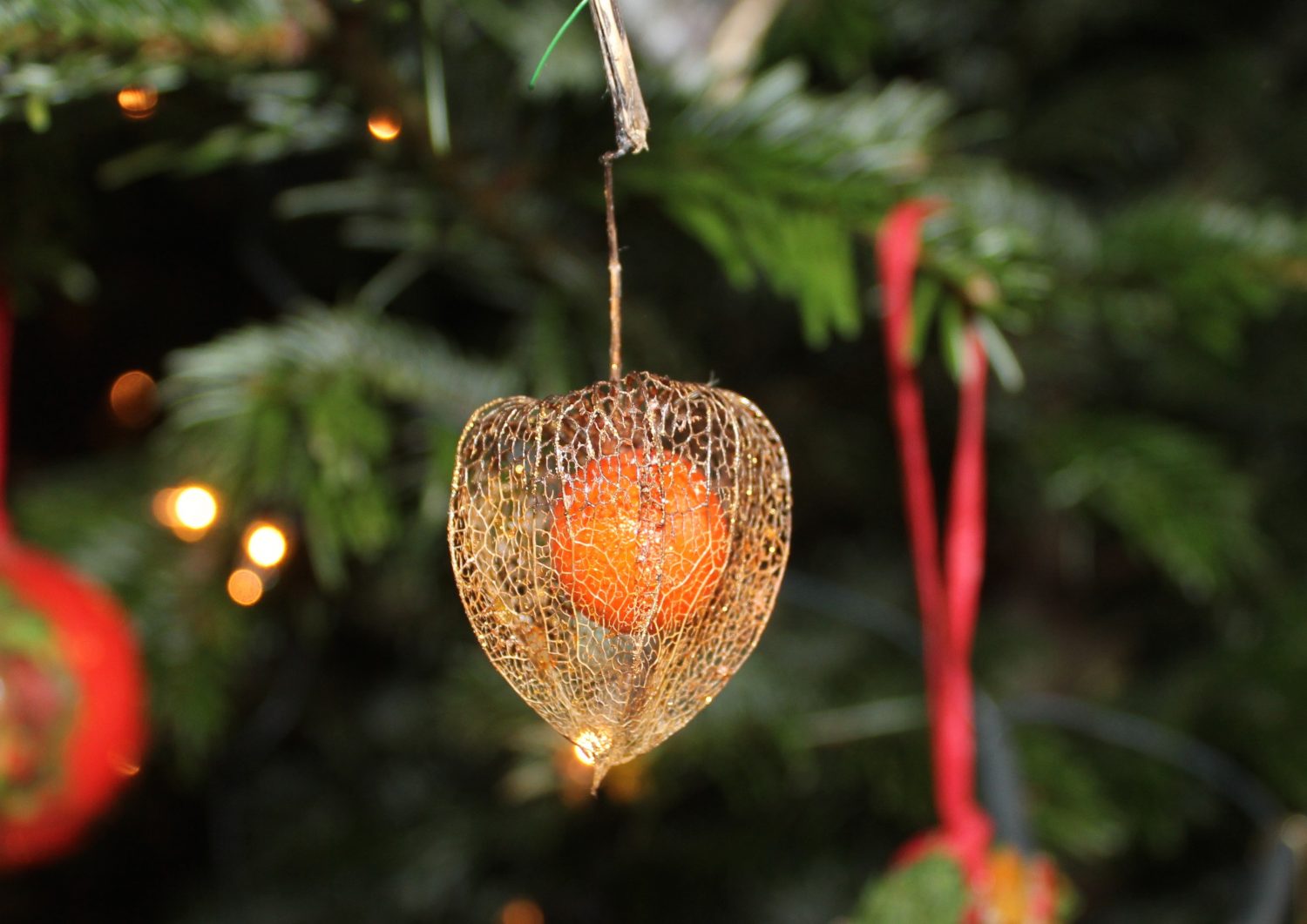
Physalis berry in skeletal pod otherwise known as a chinese lantern. These look magical hanging from the tree.
TEST
Clove studded fruit with cones
TEST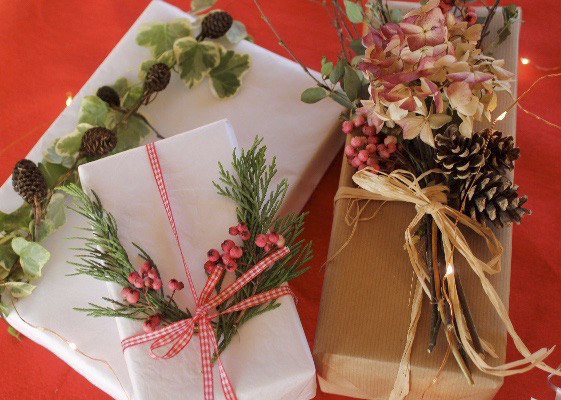
Presents with natural trimmings
TEST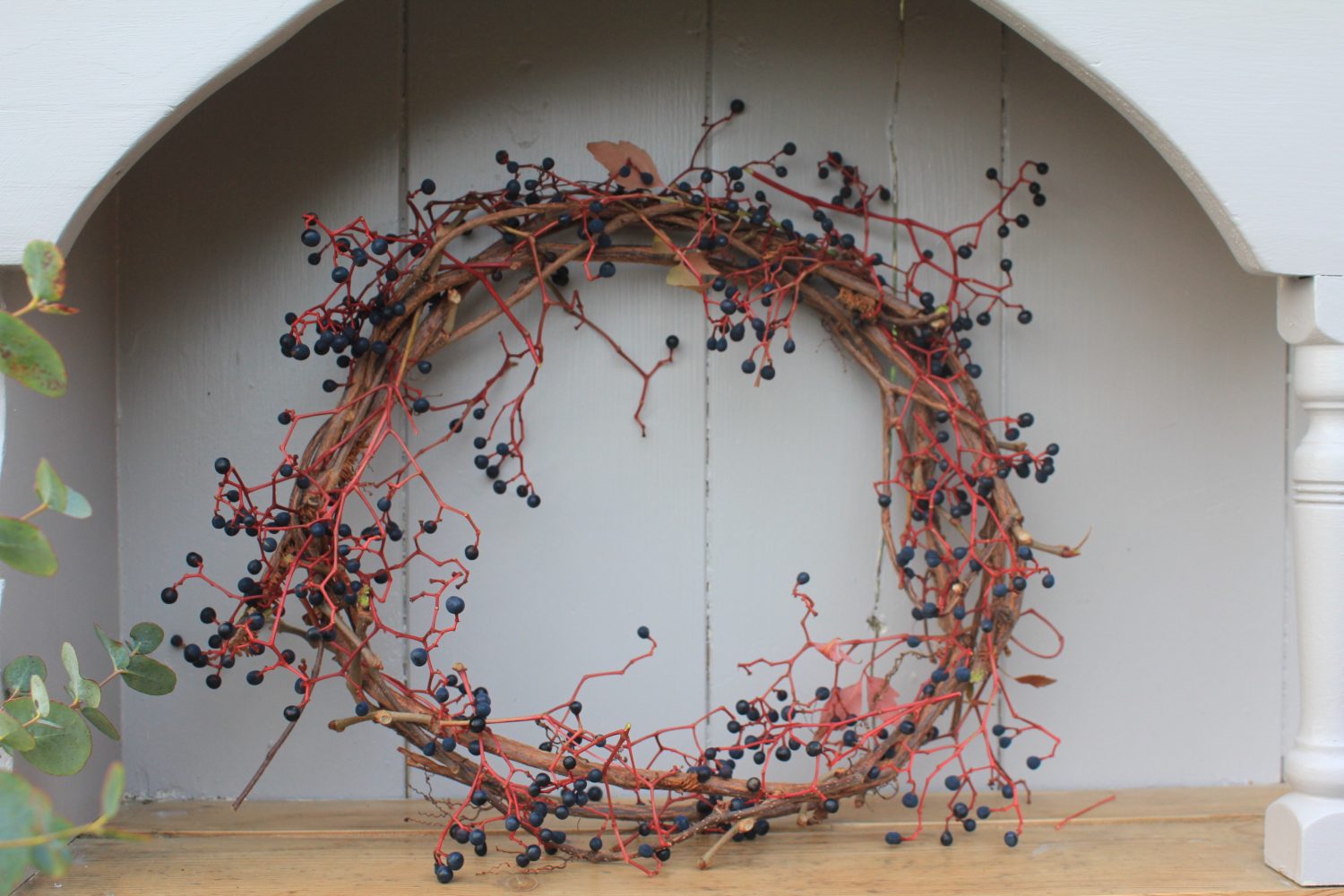
Simple wreath made from flexible virginia creeper stems and berries
TEST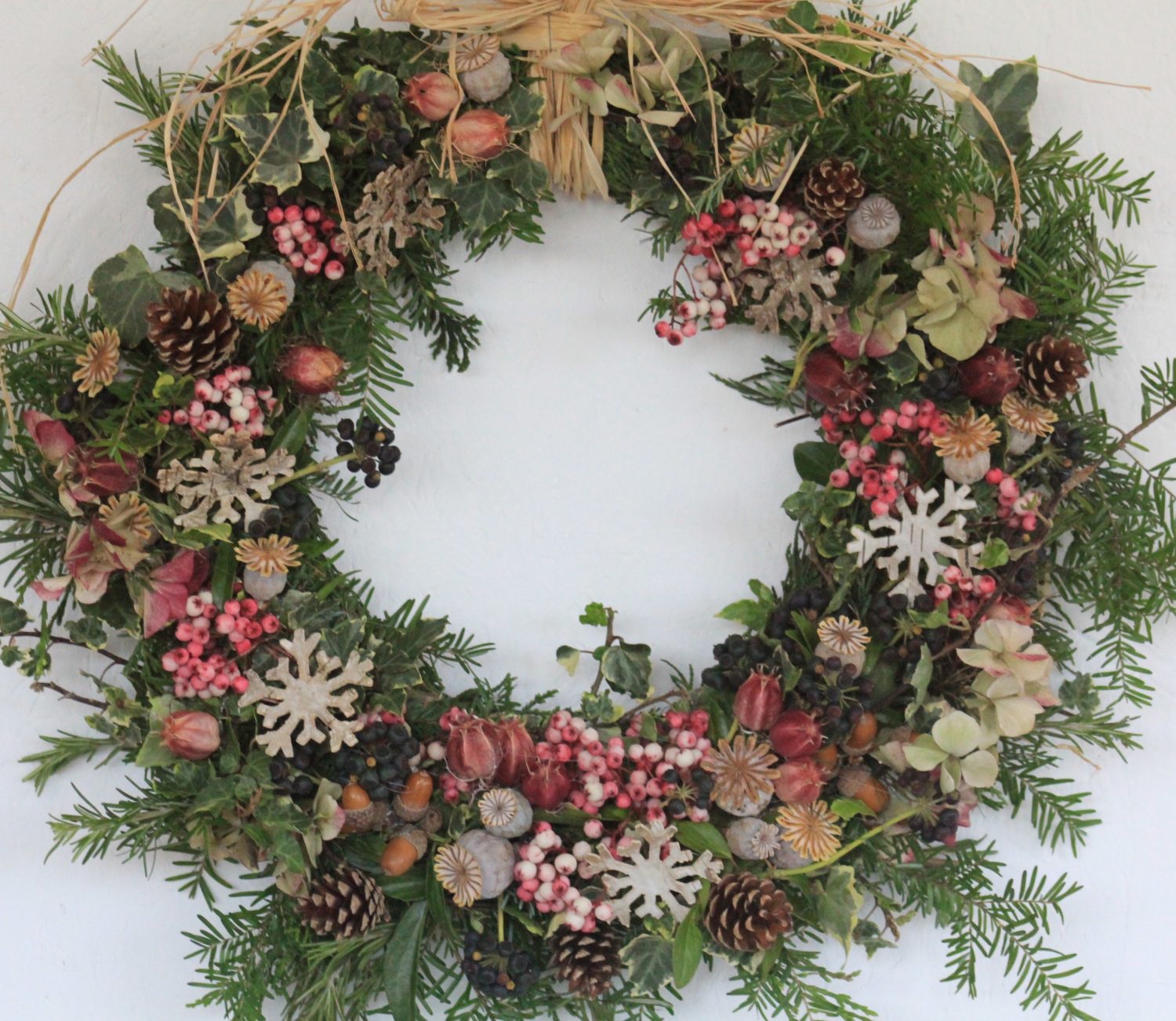
Wreath with seed heads and berries
TEST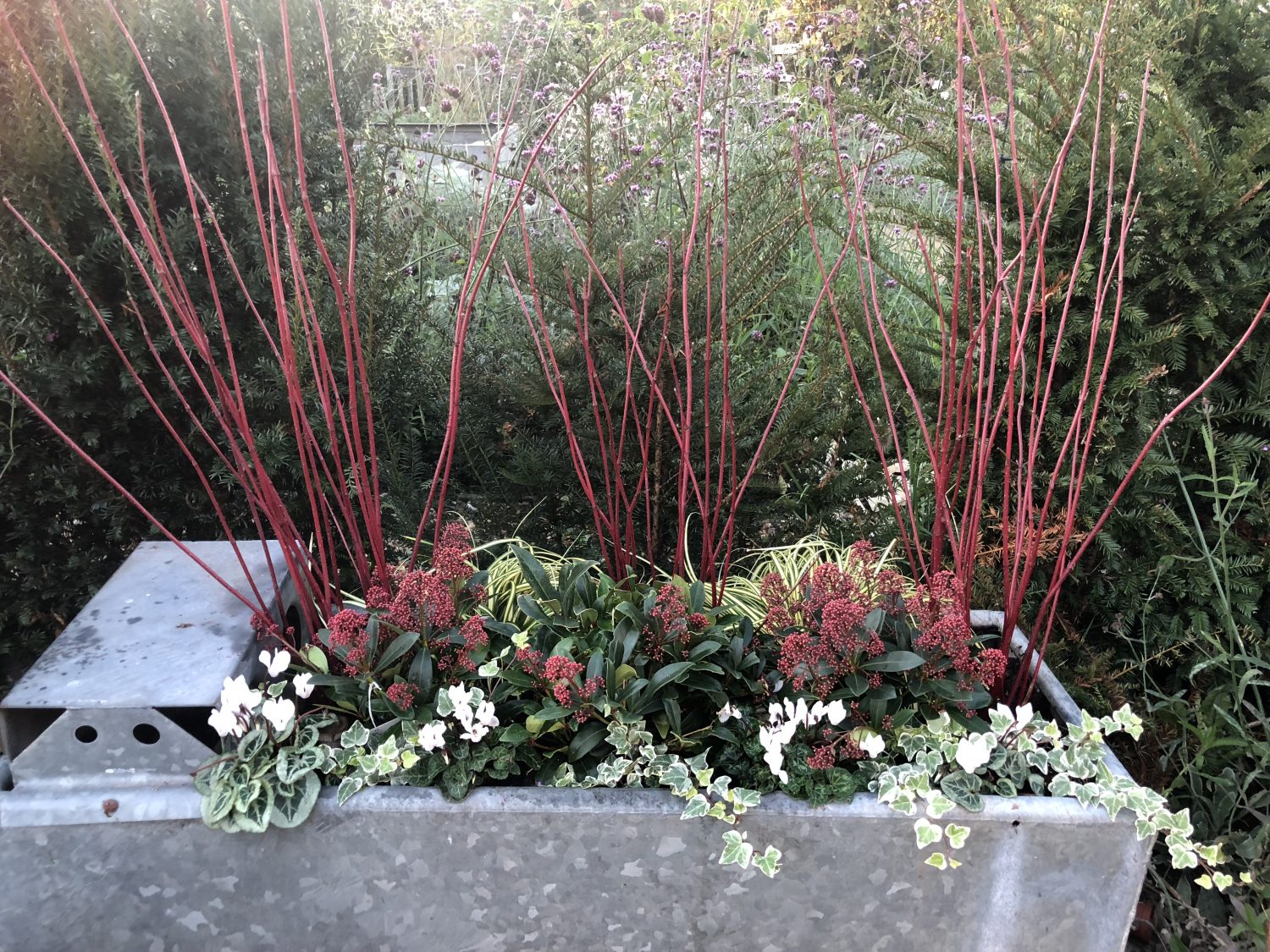
Trough with skimmia, cyclamen and dogwood creating a lovely winter display
You may also like
Go with the Flow
Sue Whigham shares some valuable new-to-gardening advice I’m sure that by now we should be used to the rain but I’m not entirely sure that we are. We had a dry, sunny day the other day and how everybody’s mood...
Farm Fables
Jane Howard gets to the bottom of why so many ponds have disappeared across the High Weald I have a new passion, almost an obsession, it’s about ponds. And there’s a distinct possibility I might become a bit of a...
Hedge Issues
Sue Whigham takes a meander along nature’s verdant and vital corridors Recently the BBC’s Today programme carried a feature about England’s hedgerows which created a lot of interest among listeners. On the strength of that, Martha Kearney interviewed one of...
